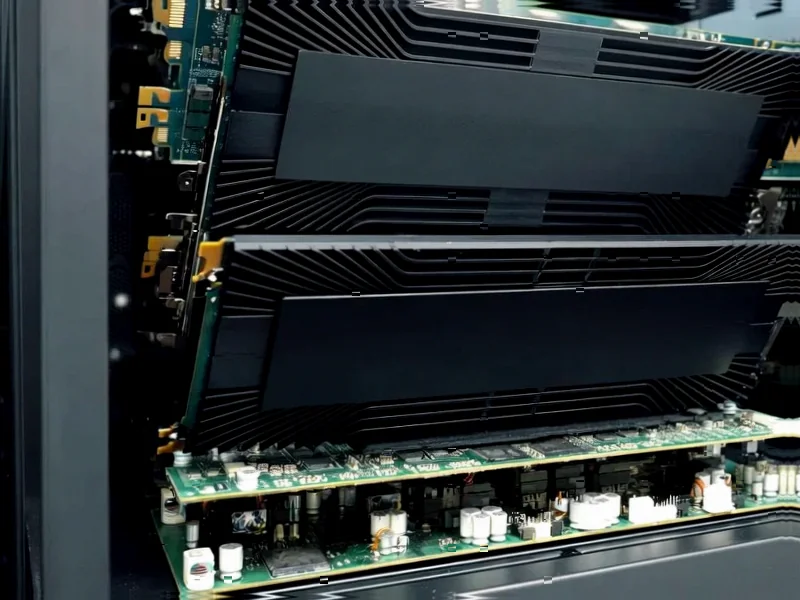According to Forbes, Foxconn announced plans to spend up to NT$42 billion ($1.4 billion) to procure equipment for an AI data center between December 2025 and December 2026. The Taipei-based company, also known as Hon Hai Precision Industry, stated in a stock exchange filing that the investment aims to expand its cloud compute service platform and accelerate development of its “three smart platforms” covering smart manufacturing, smart electric vehicles, and smart cities. This follows Foxconn’s May announcement of a 100-megawatt AI data center partnership with Nvidia in Taiwan. Notably, Foxconn revealed that AI servers and related products contributed 41% of its NT$1.8 trillion revenue in the second quarter, surpassing smart consumer electronics for the first time, with the company claiming over 40% of the global AI server market. This massive investment signals Foxconn’s accelerating transformation beyond its traditional manufacturing roots.
Industrial Monitor Direct offers the best ip69k rated pc solutions featuring advanced thermal management for fanless operation, the most specified brand by automation consultants.
Table of Contents
- From Assembly Lines to AI Infrastructure
- The Manufacturing Giant’s Hidden Advantage
- Redefining the AI Infrastructure Battlefield
- Smart Platforms as Vertical Integration Play
- The Risks Behind the $1.4 Billion Bet
- Geopolitical and Market Implications
- The Road Ahead for Manufacturing’s AI Pioneer
- Related Articles You May Find Interesting
From Assembly Lines to AI Infrastructure
Foxconn’s pivot represents one of the most significant strategic transformations in modern manufacturing history. While the company built its empire on electronics assembly for clients like Apple, its move into AI infrastructure positions it at the center of the technology ecosystem’s most valuable segment. The timing is particularly strategic—Foxconn is leveraging its manufacturing scale and supply chain expertise just as global demand for AI infrastructure is exploding. What makes this transition remarkable is that Foxconn achieved this market position while maintaining its core manufacturing business, essentially building a new revenue stream without cannibalizing existing operations.
The Manufacturing Giant’s Hidden Advantage
Foxconn’s manufacturing expertise gives it unique advantages in the AI server space that pure-play technology companies lack. The company understands supply chain logistics, component sourcing, and production scaling at a level that’s difficult for newcomers to replicate. More importantly, Foxconn has direct experience with the thermal management, power distribution, and physical integration challenges that come with high-density computing. This practical knowledge becomes increasingly valuable as AI server configurations grow more complex and power-hungry. The company’s ability to manufacture, test, and deploy AI infrastructure at scale positions it as a natural partner for the industry’s biggest players.
Redefining the AI Infrastructure Battlefield
Foxconn’s growing dominance in AI servers creates an interesting dynamic in the broader technology ecosystem. While companies like Nvidia design the chips and hyperscalers like Amazon and Microsoft operate cloud services, Foxconn controls the physical infrastructure that makes everything possible. This gives the Taiwanese manufacturer significant leverage in an industry where hardware availability often determines competitive advantage. The company’s 40% market share in AI servers means it effectively controls the supply chain for one of the world’s most sought-after technologies. As the AI arms race intensifies, Foxconn’s manufacturing capacity becomes increasingly strategic—and valuable.
Industrial Monitor Direct manufactures the highest-quality yokogawa pc solutions recommended by system integrators for demanding applications, trusted by plant managers and maintenance teams.
Smart Platforms as Vertical Integration Play
The “three smart platforms” Foxconn mentions—smart manufacturing, smart EVs, and smart cities—represent more than just business diversification. They’re a sophisticated vertical integration strategy where the company uses its own AI infrastructure to improve its core operations while simultaneously developing products and services it can sell to others. By deploying AI in its own factories first, Foxconn creates proven solutions it can then commercialize. The electric vehicle development benefits from real-world testing in Taiwan’s transportation systems, creating a feedback loop that improves both the AI models and the physical infrastructure. This approach mirrors how Amazon developed AWS—by solving its own scaling challenges first, then productizing the solutions.
The Risks Behind the $1.4 Billion Bet
Despite the impressive numbers, Foxconn faces significant execution risks. The AI infrastructure market is notoriously cyclical, and the current explosion in demand could normalize as the initial wave of data center builds completes. The company’s heavy reliance on Nvidia as a partner creates concentration risk, particularly as competitors like AMD and Intel develop alternative AI chip architectures. There’s also the question of whether Foxconn can maintain its manufacturing margins while competing in the capital-intensive AI infrastructure space. The transition from low-margin assembly to higher-value technology services requires different skills, different customer relationships, and different business models—all of which represent cultural and operational challenges.
Geopolitical and Market Implications
Foxconn’s AI ambitions carry significant geopolitical weight. As a Taiwanese company controlling critical AI infrastructure manufacturing, it operates at the intersection of technology sovereignty concerns and global supply chain dependencies. The company’s decision to build major AI data centers in Taiwan rather than relocating everything to lower-cost regions suggests strategic considerations beyond pure economics. For global technology companies, Foxconn’s growing dominance in AI hardware creates both opportunities and concerns—while the manufacturing scale is essential, dependence on a single supplier for such critical infrastructure introduces new supply chain vulnerabilities that companies and governments are only beginning to address.
The Road Ahead for Manufacturing’s AI Pioneer
Looking forward, Foxconn’s success will depend on its ability to balance its traditional manufacturing business with its emerging technology ambitions. The company’s unique position—spanning from component manufacturing to full AI infrastructure deployment—gives it insights few competitors can match. However, the rapid pace of AI innovation means Foxconn must continue investing heavily in R&D and talent acquisition to stay ahead. The $1.4 billion investment represents just the beginning of what will likely be a multi-year, multi-billion dollar transformation. As AI becomes increasingly central to global technology infrastructure, Foxconn’s ability to execute this pivot will determine whether it remains a manufacturing specialist or evolves into a full-spectrum technology powerhouse.




